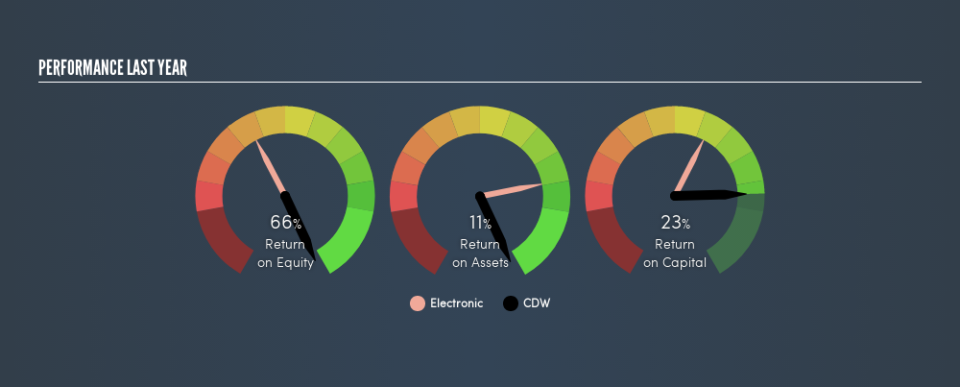Should You Like CDW Corporation’s (NASDAQ:CDW) High Return On Capital Employed?

Want to participate in a research study? Help shape the future of investing tools and earn a $60 gift card!
Today we'll evaluate CDW Corporation (NASDAQ:CDW) to determine whether it could have potential as an investment idea. To be precise, we'll consider its Return On Capital Employed (ROCE), as that will inform our view of the quality of the business.
First up, we'll look at what ROCE is and how we calculate it. Next, we'll compare it to others in its industry. Last but not least, we'll look at what impact its current liabilities have on its ROCE.
Return On Capital Employed (ROCE): What is it?
ROCE is a metric for evaluating how much pre-tax income (in percentage terms) a company earns on the capital invested in its business. Generally speaking a higher ROCE is better. Overall, it is a valuable metric that has its flaws. Renowned investment researcher Michael Mauboussin has suggested that a high ROCE can indicate that 'one dollar invested in the company generates value of more than one dollar'.
How Do You Calculate Return On Capital Employed?
The formula for calculating the return on capital employed is:
Return on Capital Employed = Earnings Before Interest and Tax (EBIT) ÷ (Total Assets - Current Liabilities)
Or for CDW:
0.23 = US$987m ÷ (US$7.2b - US$2.8b) (Based on the trailing twelve months to December 2018.)
So, CDW has an ROCE of 23%.
View our latest analysis for CDW
Does CDW Have A Good ROCE?
When making comparisons between similar businesses, investors may find ROCE useful. CDW's ROCE appears to be substantially greater than the 11% average in the Electronic industry. I think that's good to see, since it implies the company is better than other companies at making the most of its capital. Putting aside its position relative to its industry for now, in absolute terms, CDW's ROCE is currently very good.
In our analysis, CDW's ROCE appears to be 23%, compared to 3 years ago, when its ROCE was 15%. This makes us wonder if the company is improving.
Remember that this metric is backwards looking - it shows what has happened in the past, and does not accurately predict the future. ROCE can be deceptive for cyclical businesses, as returns can look incredible in boom times, and terribly low in downturns. ROCE is, after all, simply a snap shot of a single year. Since the future is so important for investors, you should check out our free report on analyst forecasts for CDW.
What Are Current Liabilities, And How Do They Affect CDW's ROCE?
Liabilities, such as supplier bills and bank overdrafts, are referred to as current liabilities if they need to be paid within 12 months. Due to the way the ROCE equation works, having large bills due in the near term can make it look as though a company has less capital employed, and thus a higher ROCE than usual. To check the impact of this, we calculate if a company has high current liabilities relative to its total assets.
CDW has total assets of US$7.2b and current liabilities of US$2.8b. Therefore its current liabilities are equivalent to approximately 39% of its total assets. A medium level of current liabilities boosts CDW's ROCE somewhat.
The Bottom Line On CDW's ROCE
Still, it has a high ROCE, and may be an interesting prospect for further research. Of course you might be able to find a better stock than CDW. So you may wish to see this free collection of other companies that have grown earnings strongly.
For those who like to find winning investments this free list of growing companies with recent insider purchasing, could be just the ticket.
We aim to bring you long-term focused research analysis driven by fundamental data. Note that our analysis may not factor in the latest price-sensitive company announcements or qualitative material.
If you spot an error that warrants correction, please contact the editor at editorial-team@simplywallst.com. This article by Simply Wall St is general in nature. It does not constitute a recommendation to buy or sell any stock, and does not take account of your objectives, or your financial situation. Simply Wall St has no position in the stocks mentioned. Thank you for reading.

